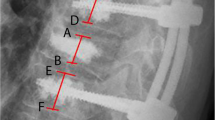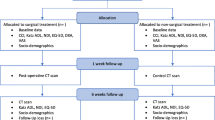Abstract
Purpose
The classification systems by Anderson and D’Alonzo, Effendi, Benzel and others have limitations when it comes to morphologically categorising fractures of the second cervical vertebral body (C2) that present with or without an additional fracture of the dens or with or without an extension of the fracture line into the vertebral arch and displacement. Currently, there are no definitive recommendations for the treatment of fractures at the junction of the dens with the vertebral body of C2 on the basis of outcome and stability data. Depending on patient anatomy, either anterior or posterior approaches can be used to fuse C1 and C2 and to achieve definitive surgical stabilisation. The anterior management of C2 fractures without C1–C2 fusion has the theoretical advantage that it preserves rotational motion at this motion segment and that the anterior approach is associated with lower morbidity. In the study presented here, we followed up a group of our patients who underwent anterior miniplate fixation for C2 fractures.
Methods
Fifteen patients underwent fixation of C2 fractures with titanium miniplates (Medartis Hand fixation system, 2.0 or 2.3 mm) that were placed using a submental approach. To our knowledge, this construct has not yet been described in the literature. Where necessary, this procedure was combined with screw fixation of the dens as described by Böhler. We retrospectively analysed operative reports and medical records, evaluated the patients’ health status using the Short Form (36) Health Survey (SF-36), and performed clinical follow-up examinations.
Results
From January 2009 to June 2015, 226 traumatic lesions of the cervical spine were managed at our institution in the inpatient setting. Ninety-two patients underwent conservative treatment. Of the 134 cases that required surgery for fractures and instability, 67 involved the C0–C3 motion segments. In 15 patients, stability was achieved using an anterior miniplate or miniscrews alone (n = 4) or in addition to other techniques (n = 11). Anderson and D’Alonzo type II and III dens fractures with involvement of the body or lateral mass of C2 accounted for eight cases. Effendi type II body fractures with or without instability were seen in four cases. There was no perioperative mortality and morbidity in this patient group. All fractures healed and stability was achieved in all cases. No patient had neurological deficits or required revision surgery. An assessment of postoperative quality of life showed that 11 patients (7 men, 4 women) with a mean age of 57 (± 5.3) years reached an SF-36 score that was normal for their age group after a mean period of 33 (± 6.3) months following their injury. Compared to a group of healthy subjects, the patients had a range of motion that was limited only at the extremes.
Conclusions
In patients with appropriate indications, anterior fixation with miniplates alone or additionally is a further useful treatment option in the management of fractures at the junction of the dens with the vertebral body of C2. Since this type of treatment preserves motion at the C1–C2 motion segment after fracture healing and since an anterior approach is associated with less surgical trauma than posterior instrumentation, the technique presented here should be included in a discussion on (surgical) treatment options.
Graphical abstract
These slides can be retrieved under Electronic Supplementary Material.






Similar content being viewed by others

References
Sime D, Pitt V, Pattuwage L, Tee J, Liew S, Gruen R (2014) Non-surgical interventions for the management of type 2 dens fractures: a systematic review. ANZ J Surg 84:320–325. https://doi.org/10.1111/ans.12401
Apfelbaum RI, Lonser RR, Veres R, Casey A (2000) Direct anterior screw fixation for recent and remote odontoid fractures. J Neurosurg 93:227–236
Magerl F, Seemann PS (1986) Stable posterior fusion of the atlas and axis by transarticular screw fixation. In: Kehr P, Weidner A (eds) Cervical Spine I. Springer, Wien, pp 322–327
Brooks AL, Jenkins EB (1978) Atlanto-axial arthrodesis by the wedge compression method. J Bone Jt Surg Am 60:279–284
Goel A (2008) C1-2 fixation. J Neurosurg Spine 9:233–235. https://doi.org/10.3171/spi/2008/9/8/233 (author reply 2)
Harms J, Melcher RP (2001) Posterior C1–C2 fusion with polyaxial screw and rod fixation. Spine 26:2467–2471
Assaghir Y (2016) Burst C2 fractures combined with traumatic spondylolisthesis: can atlantoaxial motion be preserved? Including some technical tips for reduction and fixation. Glob Spine J 6:555–562. https://doi.org/10.1055/s-0035-1569461
Jacobson ME, Khan SN, An HS (2012) C1–C2 posterior fixation: indications, technique, and results. Orthop Clin N Am 43:11–18. https://doi.org/10.1016/j.ocl.2011.09.004 (vii)
Jiang T, Yin H, Ren XJ, Chu TW, Wang WD, Li CQ (2017) Anterior reduction and fusion for treatment of massive tear drop fracture of axis combining with inferior endplate serious traversed lesion: a retrospective study. J Orthop Sci 22:816–821. https://doi.org/10.1016/j.jos.2017.06.007
Zhang Z, Mu Z, Zheng W (2016) Anterior pedicle screw and plate fixation for cervical facet dislocation: case series and technical note. Spine J 16:123–129. https://doi.org/10.1016/j.spinee.2015.09.040
Ji W, Tong J, Huang Z, Zheng M, Wu X, Chen J, Zhu Q (2016) Stabilization of the craniovertebral junction with clivus plate constructs: biomechanical comparison with conventional technique. World Neurosurg 94:42–49. https://doi.org/10.1016/j.wneu.2016.06.104
Hu Y, Dong WX, Kepler CK, Yuan ZS, Sun XY, Zhang J, Xie H (2016) A novel anterior odontoid screw plate for C1–C3 internal fixation: an in vitro biomechanical study. Spine 41:E64–E72. https://doi.org/10.1097/brs.0000000000001165
Liu C, Kuang L, Wang L, Tian J (2014) Management of combination fractures of the atlas and axis: a report of four cases and literature review. Int J Clin Exp Med 7:2074–2080
Denaro V, Papalia R, Di Martino A, Denaro L, Maffulli N (2011) The best surgical treatment for type II fractures of the dens is still controversial. Clin Orthop Relat Res 469:742–750. https://doi.org/10.1007/s11999-010-1677-x
Joaquim AF, Patel AA (2011) Craniocervical traumatic injuries: evaluation and surgical decision making. Glob Spine J 1:37–42. https://doi.org/10.1055/s-0031-1296055
Bullinger M, Blome C, Sommer R, Lohrberg D, Augustin M (2015) Health-related quality of life: a pivotal endpoint in benefit assessment of medical procedures. Bundesgesundheitsblatt, Gesundheitsforschung, Gesundheitsschutz 58:283–290. https://doi.org/10.1007/s00103-014-2107-0
Ellert U, Kurth BM (2013) Health related quality of life in adults in Germany: results of the German Health Interview and Examination Survey for Adults (DEGS1). Bundesgesundheitsblatt, Gesundheitsforschung, Gesundheitsschutz 56:643–649. https://doi.org/10.1007/s00103-013-1700-y
Herren C, Pishnamaz M, Lichte P, Hildebrand F, Sellei RM, Pape HC, Kobbe P (2015) The anterior “triple-/quadruple” technique for C1/C2 trauma in the elderly: first experience with 16 patients. Zeitschrift fur Orthopadie und Unfallchirurgie. https://doi.org/10.1055/s-0035-1546133
Koller H, Acosta F, Forstner R, Zenner J, Resch H, Tauber M, Lederer S, Auffarth A, Hitzl W (2009) C2-fractures: part II. A morphometrical analysis of computerized atlantoaxial motion, anatomical alignment and related clinical outcomes. Eur Spine J 18:1135–1153. https://doi.org/10.1007/s00586-009-0901-4
Lohrer L, Raschke MJ, Thiesen D, Hartensuer R, Surke C, Ochman S, Vordemvenne T (2012) Current concepts in the treatment of Anderson Type II odontoid fractures in the elderly in Germany, Austria and Switzerland. Injury 43:462–469. https://doi.org/10.1016/j.injury.2011.09.025
Shousha M, Mosafer A, Boehm H (2014) Infection rate after transoral approach for the upper cervical spine. Spine 39:1578–1583. https://doi.org/10.1097/BRS.0000000000000475
Zhang YS, Zhang JX, Yang QG, Shen CL, Li W, Yin ZS (2014) Surgical management of the fractures of axis body: indications and surgical strategy. Eur Spine J 23:1633–1640. https://doi.org/10.1007/s00586-013-3158-x
Huybregts JG, Jacobs WC, Vleggeert-Lankamp CL (2013) The optimal treatment of type II and III odontoid fractures in the elderly: a systematic review. Eur Spine J 22:1–13. https://doi.org/10.1007/s00586-012-2452-3
Iizuka H, Tomomatsu Y, Sorimachi Y, Ara T, Mieda T, Iizuka Y, Takagishi K (2016) Clinical findings of conservative cases with a coronally oriented vertical fracture of the posterior region of the C2 vertebral body. Eur Spine J 25:110–114. https://doi.org/10.1007/s00586-015-4187-4
Jubert P, Lonjon G, Garreau de Loubresse C, Bone, Joint Trauma Study Group G (2013) Complications of upper cervical spine trauma in elderly subjects. A systematic review of the literature. Orthop Traumatol Surg Res OTSR 99:S301–S312. https://doi.org/10.1016/j.otsr.2013.07.007
Maurischat C, Morfeld M, Kohlmann T, Bullinger M (2004) Lebensqualität. Pabst Science Publishers, Lengerich
Koller H, Reynolds J, Zenner J, Forstner R, Hempfing A, Maislinger I, Kolb K, Tauber M, Resch H, Mayer M, Hitzl W (2009) Mid- to long-term outcome of instrumented anterior cervical fusion for subaxial injuries. Eur Spine J 18:630–653. https://doi.org/10.1007/s00586-008-0879-3
Fehlings MG, Arun R, Vaccaro AR, Arnold PM, Chapman JR, Kopjar B (2013) Predictors of treatment outcomes in geriatric patients with odontoid fractures: AOSpine North America multi-centre prospective GOF study. Spine 38:881–886. https://doi.org/10.1097/BRS.0b013e31828314ee
Author information
Authors and Affiliations
Corresponding author
Ethics declarations
Conflict of interest
The authors declare that this research was not sponsored. The authors maintain full control of all primary data and declare no conflict of interest in relation to this work. None of the authors received financial support from any of the manufacturers of products mentioned in this article.
Electronic supplementary material
Below is the link to the electronic supplementary material.
Rights and permissions
About this article
Cite this article
Franke, A., Bieler, D., Wern, R. et al. Anterior management of C2 fractures using miniplate fixation: outcome, function and quality of life in a case series of 15 patients. Eur Spine J 27, 1332–1341 (2018). https://doi.org/10.1007/s00586-018-5556-6
Received:
Revised:
Accepted:
Published:
Issue Date:
DOI: https://doi.org/10.1007/s00586-018-5556-6



